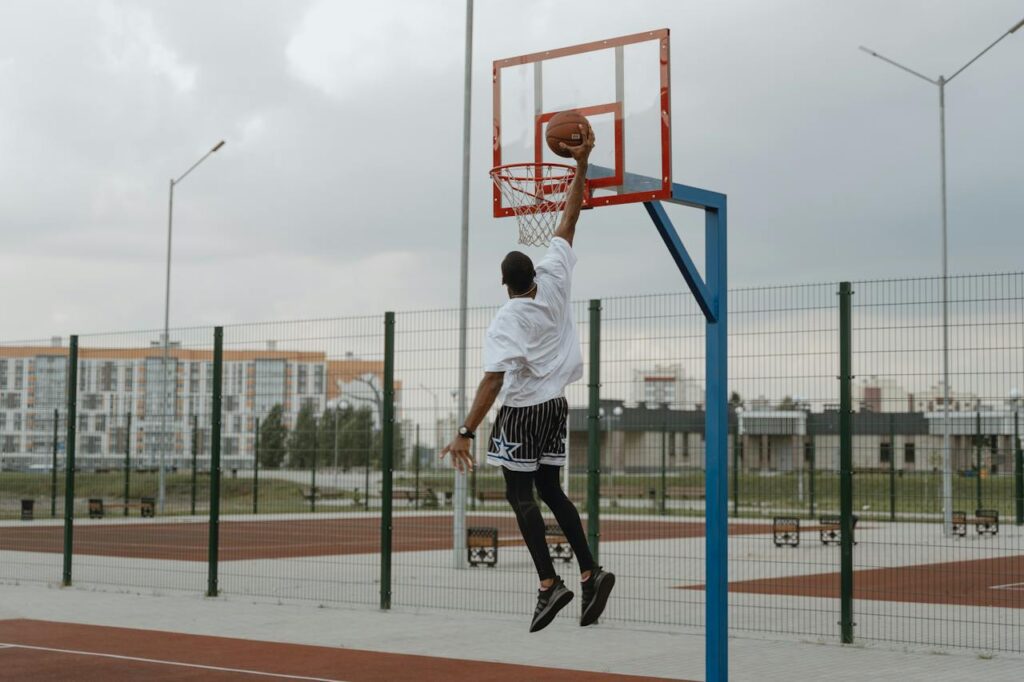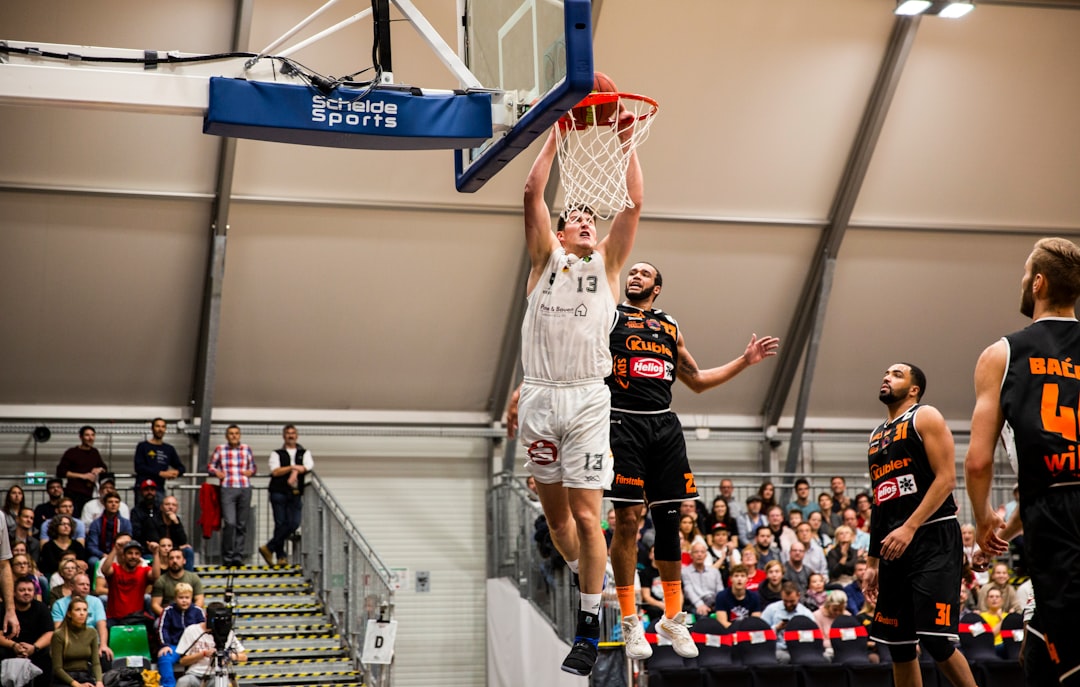The Myth of Height and Age in Dunking
Dunking a basketball is often perceived as an ability reserved for exceptionally tall or young individuals. However, the reality is that successful dunking is not solely determined by height or age. Instead, it is heavily reliant on muscle strength, power, and vertical jump performance. These physical attributes can be developed and improved through targeted training and exercises, regardless of an individual’s height or age. One remarkable example that defies the myth of age and height in dunking is the story of Andy Nicholson, also known as the “Over-the-Hill Dunker.” Despite standing at 5-foot-11 and having no competitive basketball experience, Nicholson achieved his dunking dream at the age of 39. His journey serves as a powerful testament to the fact that with dedication, perseverance, and the right training, individuals can surpass age and height limitations to realize their dunking aspirations. Nicholson’s inspiring story showcases the power of commitment and hard work in overcoming perceived obstacles to achieve one’s dunking goals. His achievement emphasizes the importance of focusing on training and developing the necessary physical attributes, rather than being limited by age or height constraints.
Moreover, it’s important to recognize that numerous individuals have defied the myth of height and age in dunking. For instance, there are several documented cases of individuals who have achieved remarkable dunking feats despite not fitting the conventional physical profile associated with successful dunking. These examples further reinforce the idea that with the right training and dedication, dunking is an attainable goal for individuals of varying heights and ages. By emphasizing the significance of muscle strength, power, and vertical jump performance, these stories serve as motivating reminders that dunking is not limited to a specific demographic but is achievable through dedicated training and perseverance.
Understanding Jump Training
To improve one’s vertical leap for basketball dunking, it is essential to understand the fundamental components of jump training. Strength training, power training, and jump training form the cornerstone of any effective vertical jump workout program. By focusing on these essential components, individuals can make significant strides in enhancing their muscle strength, power, and overall vertical jump performance. For instance, strength training plays a pivotal role in jump training as it helps in building the necessary muscle power and explosiveness required for successful dunking. Incorporating exercises such as squats, lunges, deadlifts, and calf raises are fundamental in strengthening the lower body muscles, which are essential for generating the force needed to propel oneself upwards during a jump. Furthermore, resistance training can aid in developing the explosive power needed to elevate off the ground with speed and agility.
In addition to strength training, power training is equally important in jump training. Power exercises such as plyometric jumps, box jumps, and medicine ball throws are designed to improve the rate of force production, allowing individuals to exert maximum force in minimal time, thus contributing to higher vertical jumps. These exercises focus on enhancing fast-twitch muscle fibres, which are essential for explosive movements such as jumping. Moreover, jump training specifically targets the mechanics of the jump, working on techniques to maximize the vertical leap through specific exercises and drills. It emphasizes the coordination, timing, and form required for an effective and powerful jump.
Furthermore, it’s crucial to recognize that a well-structured training program can significantly contribute to jump training success. The “How to Dunk Like a Pro” audiobook provides detailed methods for strength training, power training, and jump training, offering a comprehensive 8-week training program to enhance vertical jump and dunking ability. This structured approach serves as a valuable resource for individuals looking to improve their dunking abilities by incorporating essential training components into their workout regimen.
The Role of Progressive Training
Progressive training approaches have demonstrated great promise in enhancing vertical jump abilities. These methods gradually increase the intensity and difficulty of workouts, pushing the body to new limits. One exemplary program, VertShock, is known for preventing plateaus in vertical jump progress, ensuring continuous improvement for individuals aspiring to increase their jumping power. For instance, the VertShock program employs a progressive training approach, gradually increasing the intensity and difficulty of workouts to push the body to new limits. This ensures continuous improvement and prevents plateaus in vertical jump progress. The promise of rapid results and accessibility of programs like VertShock make it an ideal choice for individuals looking for quick improvement in their vertical jump abilities.
Moreover, the effectiveness of progressive training can be further exemplified through real-life success stories. For instance, a 56-year-old individual embarked on a 30-day journey to learn how to dunk by committing to the VertShock program. The individual reported significant gains in their vertical jump within just a few weeks of starting the program, underscoring the rapid results and accessibility of VertShock as an effective platform for achieving quick improvement. These examples illustrate the potential of progressive training approaches to defy age limitations and enhance vertical jump abilities.
Dunking Throughout History
Dunking holds historical significance, with the first documented dunk attributed to Joe Fortenberry. This pivotal moment in basketball history marked the inception of a phenomenon that would go on to revolutionize the sport. As a farm boy from Happy, Texas, Fortenberry’s dunk was the first aesthetically stirring display of this skill. This act defied the rules of both Newton and Naismith, leaving spectators flabbergasted by the display of athleticism and audacity. The inadequacies of modern language have often been blamed for the inability to fully capture the essence of the dunk, which not only defies the earliest tenets of the game but also carries a unique and defiant anger in its execution.
Furthermore, the historical evolution of dunking has significantly impacted basketball athleticism. It has become a symbol of excellence, representing the relentless pursuit of vertical jump abilities and the realization of dunking dreams. Over the years, famous dunkers have either been reticent on the subject or found it challenging to express the indescribable feeling of defying gravity. Their journeys have inspired countless individuals to push the boundaries of what was once thought to be impossible. The dunk has transcended the realms of sport and athleticism, becoming a universal symbol of overcoming limitations and achieving extraordinary feats.
Personal Dunking Journeys
Inspiring personal stories of individuals defying age and height limitations to achieve their dunking dreams serve as motivation for aspiring dunkers. One remarkable example is the story of Andy Nicholson, known as the “Over-the-Hill Dunker,” who achieved his dream of dunking at the age of 39. Despite being 5-foot-11 and having no competitive basketball experience, Nicholson’s perseverance and dedication to training allowed him to become a revered figure in the dunking community. His journey, from watching the 1986 NBA dunk contest and being inspired by Spud Webb to reigniting his passion for dunking at the age of 40, is a testament to the fact that dunking is achievable regardless of age or height.
In addition to Nicholson’s story, numerous other individuals have experienced similar triumphs through rigorous training efforts. These personal accounts showcase the incredible impact of consistent and focused training regimens in defying physical limitations. From individuals who have trained rigorously with online jump programs to those who have participated in dedicated dunk camps, these stories underscore the importance of perseverance, discipline, and the right training program in achieving the seemingly impossible goal of dunking a basketball. These accounts are a testament to the fact that with the right approach and determination, dunking is a realistic aspiration for anyone willing to put in the effort and dedication.
Dietary Considerations for Jump Training
The importance of dietary information for optimal training and performance improvement cannot be understated. Understanding how nutrition complements jump training is essential for achieving enhanced results and maximizing the impact of training efforts. Nutrition plays a pivotal role in jump training as it directly impacts an athlete’s energy levels, muscle recovery, and overall physical performance. Consuming a well-balanced diet rich in lean proteins, complex carbohydrates, healthy fats, and essential vitamins and minerals is crucial for fueling the body and supporting muscle growth and repair. For example, incorporating foods like chicken, fish, quinoa, sweet potatoes, avocados, and leafy greens can provide the necessary nutrients to optimize training outcomes.
In addition to macronutrients and micronutrients, adequate hydration is paramount for jump training success. Staying well-hydrated supports overall athletic performance, aids in recovery, and helps prevent fatigue and cramping during training sessions. Hydration should be a key focus for anyone looking to improve their vertical jump and dunking ability. Furthermore, understanding the timing of meals and snacks during training sessions is essential. Consuming a balanced meal or snack with the right macronutrient composition before and after workouts can support energy levels, muscle recovery, and adaptation to training stimuli.
Moreover, dietary strategies and considerations are crucial for individuals looking to optimize jump training and performance improvement. The “How to Dunk Like a Pro” audiobook offers valuable insights into the role of nutrition in achieving dunking success, emphasizing the importance of a well-rounded approach to training, encompassing both physical workouts and dietary considerations. By incorporating these dietary recommendations and strategies into their training regimen, individuals can maximize the impact of their jump training efforts.
Building Core Strength and Agility
Improving dunking performance involves developing core strength and agility, which are essential components of a comprehensive training program. Core strength forms the foundation for explosive power and stability needed to execute a successful dunk. Incorporating exercises such as planks, Russian twists, and leg raises can help strengthen the core muscles, including the abdominals, obliques, and lower back, ultimately leading to improved jumping ability and dunking performance. Moreover, agility training is equally crucial as it enhances dynamic movement, coordination, and balance – all of which are vital for executing powerful and precise dunks on the basketball court. Plyometric exercises, ladder drills, and cone drills are effective in improving agility, enabling athletes to move quickly and efficiently, crucial for positioning and take-off during a dunk attempt.
These aspects of training underscore the comprehensive approach required to achieve dunking success, highlighting the importance of not only vertical jump training but also the development of core strength and agility. By incorporating these training methods into a jump training program, individuals can enhance their overall athleticism and take their dunking abilities to the next level. Furthermore, the incorporation of core strength and agility exercises into a comprehensive jump training program is essential for individuals seeking to maximize their dunking potential and elevate their athletic performance.
Testimonials and Success Stories
Sharing inspiring personal stories of individuals defying age and height limitations to achieve their dunking dreams can provide valuable motivation and encouragement for aspiring dunkers. One remarkable example is Andy Nicholson, also known as the “Over-the-Hill Dunker,” who fulfilled his dream of dunking a basketball at the age of 39, despite being 5-foot-11 and having no competitive basketball experience. This demonstrates that with the right training and dedication, dunking is achievable regardless of age or height. Moreover, the “How to Dunk Like a Pro” audiobook features success stories of basketball athletes who have followed its methods for strength training, power training, and jump training. These individuals have experienced significant gains in their vertical jump and have successfully realized their dunking aspirations. These real-life examples serve as a source of inspiration and validation for those looking to enhance their vertical leap for basketball dunking. These testimonials and success stories provide valuable insights into the effectiveness of various jump training programs and serve as motivation for individuals looking to embark on their journey towards dunking success.
The No-Bullshit Guide to Jumping Higher
The “How to Dunk Like a Pro” audiobook not only provides a comprehensive overview of methods for strength training, power training, and jump training but also emphasizes the importance of overcoming height and age limitations in dunking. This guide challenges the myth that successful dunking is solely determined by height or age, shedding light on the fact that muscle strength, power, and vertical jump performance are crucial elements for achieving dunking dreams. For instance, Andy Nicholson, known as the “Over-the-Hill Dunker,” achieved his dunking dream at the age of 39, despite being 5-foot-11 and having no competitive basketball experience. His remarkable journey stands as a testament to the idea that dunking is an achievable goal regardless of height or age. By highlighting such inspiring stories, the audiobook motivates individuals to take the first step towards improving their dunking ability, challenging conventional beliefs about dunking and encouraging readers to pursue their dunking aspirations.
The “How to Dunk Like a Pro” audiobook serves as a guide for jump training and a source of empowerment, urging readers to defy limitations and work towards their dunking goals. It provides valuable insights into the essential components of an effective vertical jump workout program, offering practical advice and strategies for individuals seeking to enhance their vertical leap for basketball dunking. This comprehensive resource ultimately serves as a compelling call to action, directing readers to explore the audiobook further and take proactive steps towards achieving their dunking dreams. By empowering individuals with valuable training strategies and inspiring success stories, the audiobook offers a comprehensive guide for those looking to elevate their dunking abilities and reach new heights in their athletic pursuits.
The Path to Dunking Success
The myth that successful dunking is solely determined by height or age has been debunked through inspiring real-life stories. One such example is Andy Nicholson, the “Over-the-Hill Dunker,” who fulfilled his dream of dunking a basketball at the age of 39, despite being 5-foot-11 and having no competitive basketball experience. This demonstrates that with the right training and dedication, dunking is achievable regardless of age or height. Such stories serve as powerful motivation for individuals looking to improve their vertical leap for basketball dunking. Understanding the essential components of jump training, including strength training, power training, and jump training, is crucial for building the necessary muscle strength, power, and vertical jump performance required for successful dunking. The “How to Dunk Like a Pro” audiobook provides a comprehensive 8-week training program that encompasses these key components, offering a roadmap for individuals to enhance their vertical jump and dunking ability. By embracing progressive training approaches like VertShock, which ensures continuous improvement and rapid results, aspiring dunkers can take proactive steps towards defying gravity and achieving their dunking dreams. For those looking to embark on their path to dunking success, exploring jump training programs and resources is essential. By leveraging the guidance and dedication offered by comprehensive training programs, individuals can begin their journey towards improving their dunking abilities and reaching new heights in their athletic pursuits.







